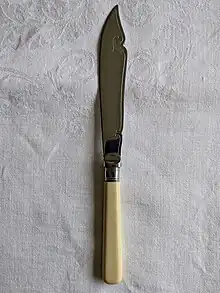
The fish knife together with fish fork represent a set of utensils specialized for eating fish. Fish knife is a strange-looking, purposedly blunt implement.[1]
History

Fish knives, like most highly specialized utensils, date back to Victorian era. The fish knife was preceded in the 18th century by a silver fish slice (also known as fish trowel, fish carver, and fish knife[2]),[1] a broad tool used for serving fish (thus yet another name, fish server), pudding,[3] and other soft desserts . At the turn of the 19th century, the originally symmetric and broad blade of the serving fish knife evolved into a scimitar-like shape, with the knife often marketed as a matched set with a four-tine serving fork.[4]
Prior to the modern fish knife introduction in the 19th century, aristocracy ate fish with two dinner forks, one to separate a piece, another one to eat. The other approach used a single fork, with a slice of bread for assistance.[5] Use of the knife came from the rich commoners, with high society at first frowning upon it as a too specialized tool (and the one they were also missing in their hereditary silverware sets).[6]
Use of silver as a material for the knife was the only available mean (before the arrival of the stainless steel) to enable pairing of lemon and fish without encountering a metallic taste.[7]
Construction

The knife has a distinct shape that evolved from a fish server. The modern knives are about 8 to 9 inches long, have a dull blade and frequently a notch close to the sharp tip that can be used to separate the bones from the flesh of the fish.[6]
Use
The fish knife is not designed for cutting. Since for fish no force is required for separating the flesh from the bones, the knife is supposed to be held between the thumb and two first fingers (like a pencil[8]) and used to fillet the fish, lift the skeleton, and remove the small remaining bones.[9] If the fish is served already without bones, knife is used to "flake" the pieces onto the fork, its use can be avoided altogether ("American style").[8]
Symbol
Fish knives and forks were originally very expensive silverware items, allowing the well-to-do to use them as a class marker, status symbols that are used to indicate the user or owner's elite status.[7] After the invention of electroplating, knife and fork sets became more affordable by 1860s, but the possession of them still indicated belonging to the "comfortable" middle class.[1] By the middle of the 20th century the nice fish knife and fork sets became a symbol for upper-class aspirations of a household. John Betjeman starts his poem "How to get on in society" (1958) with a pursuit of fish knives as a symbol of pretensions (Phone for the fish knives ... I must have things daintily served).[10]
In the 21st century use of the fish knives at a restaurant is also a symbol of high aspirations (perhaps, for a Michelin star).[11]
References
- 1 2 3 Cool 2009, p. 12.
- ↑ Worcester 1860, p. 559, fish knife, fish slice, fish trowel.
- ↑ Wees 1997, p. 257, Fish Slice.
- ↑ Von Drachenfels 2000, p. 212, Fish Servers.
- ↑ A Member of the Aristocracy 1898, p. 115.
- 1 2 Von Drachenfels 2000, p. 184, Fish Knife.
- 1 2 Hudson 2023, p. 100.
- 1 2 Moore 1998, p. 143.
- ↑ Von Drachenfels 2000, p. 235, Fish Knife and Fish Fork.
- ↑ Cool 2009, p. 13.
- ↑ Cool 2009, p. 14.
Sources
- Von Drachenfels, Susanne (2000). The Art of the Table: A Complete Guide to Table Setting, Table Manners, and Tableware. Simon & Schuster. ISBN 978-0-684-84732-0. Retrieved 2023-10-07.
- Cool, H.E.M. (2009). "Fish knives, silver spoons and red dishes" (PDF). Food and Drink in Archaeology 2. University of Nottingham Postgraduate Conference 2008. Totnes: Prospect Books. ISBN 1-903018-68-4.
- Wees, B.C. (1997). English, Irish, & Scottish Silver at the Sterling and Francine Clark Art Institute. Hudson Hills Press. ISBN 978-1-55595-117-7. Retrieved 2023-10-14.
- Worcester, J.E. (1860). A Dictionary of the English Language. Hickling, Swan and Brewer. Retrieved 2023-10-14.
- Hudson, A. (2023). The Soul of Civility: Timeless Principles to Heal Society and Ourselves. St. Martin's Publishing Group. ISBN 978-1-250-27779-4. Retrieved 2023-10-14.
- Moore, J.H. (1998). The Etiquette Advantage: Rules for the Business Professional. Life@Work Series. Broadman & Holman. ISBN 978-0-8054-0154-7. Retrieved 2023-10-15.
- A Member of the Aristocracy (1898). Manners and Rules of Good Society: Or, Solecisms to be Avoided. F. Warne. Retrieved 2023-10-16.